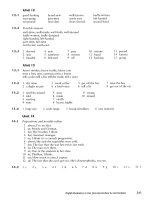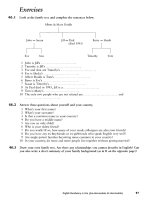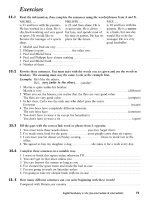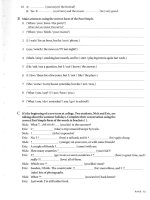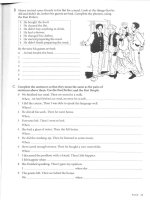Pair work 1 Elementary Pre Intermediate phần 1 docx
Bạn đang xem bản rút gọn của tài liệu. Xem và tải ngay bản đầy đủ của tài liệu tại đây (622.01 KB, 10 trang )
.
.
,-
',.<"
.:
I-,
.
?:',
.
-
Pair
Elementary- Pre-Intermediate
New
Edition
-
P,
"
,'.*1
Peter WatcynmJones and
*.
9eirdre HowardmWilliams
I
i
Series Editor
Peter WatcynmJones
S
ENGLISH PHOTOCOPIABLES Contents
Introduction
Part
1
Teacher's notes
Part
2
Material for
photocopying
Game/Activity Time Main
functions
Key
to
contents table
Preparation
one handout to copy
@
several handouts to copy
%
one handout to copy and cut up
Level
@
=
beginner (suitable for beginner
students and above)
0 0
=
elementary (suitable for elementary
students and above)
0
0
@
=
pre-intermediate (suitable for pre-intermediate
students and above)
Main
grammar
Preparation Pages
Ice-breaker/Warm-up activities
1
Getting to know
20
mins Asking for and giving
you. personal information
Asking about and
expressing likes and
dislikes
Filling in a form
Asking how to spell a
name
Spelling your name
Asking questions, using the
12/40
verb
to be
and the auxiliary
do
with the present tense
Using question words:
what/
wherehow,
etc.
What's your
?/Where do
. .
.?/
How many
?/How do
?
Using the present simple first person
to talk about oneself:
I live
Aspeak
Using the present simple third person
to talk about another person:
He/she likeddoesn't like
.
2
This is my
30
mins Asking about and Asking questions with
what
D
1214142
favourite!
expressing and the verb
to be: What's
Do you agree?
@
personal preferences
your favourite?
Offering alternatives
Answering with the verb
to be:
My favourite is
.
.
.
3
I
think
I
know
20-25
Speculating about a person Common verbs in the present
you.
@
mins Asking for information
tense:
be/have/got/go/live/listen/
about a person
watch/read,
etc.
IL4
13143-44
Giving information Use of
can
to express ability
about yourself
Use of
want
to express the wish to
do something
First and third person:
I'm
/He's
. .
./
I can
/She can
,
etc.
Asking questions:
Are you
.
?/
Have you got
. .
.?/Can you
. . .
?/
Do you
. .
.?
Use of negative first and third
person:
He isn't A can't
/I
don't
/
She hasn't got
.
. .
Short answers using
am/can/have/do
in positive and negative:
Yes, I can/
No I
can't/Yes,
I
ammo,
I
don't
Comparatives:
older
4
This is
25
mins Explaining what certain Understanding a variety of
1414546
important things mean and refer to questions:
What
.?/
tome.
0
Asking a variety of
Which
?/How many
?/How old
?
questions to find out Expressing times, numbers,
further information days and dates
Present tense of various verbs:
wear/finish/live,
etc.
3
Game/Activity Time Main Main Preparation Pages
functions grammar
5
What we do at 25-30 Talking about likes and The gerund
-
as used to talk
L9
1514748
weekends mins dislikes about activities:
watching
Discussing weekend
telm'sion/cooking/doing the
activities
washing up,
etc.
Ranking activities in order The use of the gerund following:
of preference
like/hate/dislike/don't like: I hate doing
things in the
kitchenn like spending time
with friends,
etc.
6 Something
20 mins Word associations
Think
+
of
D
15/49
@@@
Talking about thoughts and Asking questions:
What do you
reactions
think of when you think of something
. .
.?
Comparing our reactions to
Expressing reactions:
I think of /My
those of others
partner thinks of
.
both: We both think of
.
7
Associations
20 mins Word webs
-
expanding Using the past tense:
My
16/50
@@@
vocabulary by extending
fourth word was
/I
chose
.
. .
word families Asking questions using the
Asking for and giving
past tense:
What word did you
reasons
have?/What was your fourth
word?/Why did you choose
. .
.?,
etc.
Giving reasons using
because
Simulations/Role plays
8
At the post 25-30 Buying stamps to send mail Asking questions:
How much does
17/51-52
office
mins (at a post office)
it cost?/How much does it weigh?
Simple greetings, requests Use of
would: I'd like to
/
and thanks
Would you like
?
Asking about and giving Numbers up to 430
information about cost
(using pounds and pence)
Asking about and giving
information about weight
(using grammes)
9
This is my 15-20 Giving information about a Present tense third person:
He
D
17/53-54
brother
mins third person
livesme works/He enjoys,
etc.
L
Asking questions
Asking questions (present tense
Talking about a photograph third person):
Is he
?/What does
Showing a polite interest in
he
?/How old is he
. ?
etc.
what somebody tells you Use of
would
to be polite:
Would you
like to see
?/Yes, I'd love to see
. . .
10 Renting a holiday 15 mins Asking for and giving
.
Asking questions (present 18/55
home
information about a tense and various question
Property
words):
Where is
.
.
.?/How big
Talking about facilities
is
?/When is
. .
.?,
etc.
Talking about needs and Giving information:
It's near
.
.
./
preferences
It costs
.
.
.,
etc.
Making a phone call Use of
want to
and
would like: We want
to come
/We'd like a room
,
etc.
11
Celebrity 20 mins Asking for and giving Question words:
how/where/
D
19/56
interview
personal information
when/who/what,
etc.
Welcoming and thanking Asking questions in the present:
Responding to welcome and
Do you
?/How
are you?,
etc.
thanks Present tense to talk about daily life
Use of
may: May I ask
. .
.?
Use of
thank you for
+
gerund:
Thank
you for answering
.
.
.
12 Eye witness 20 mins Describing a person
-
Past tenses in the affirmative,
D
19/57-58
@@@
physical features interrogative and negative
Describing clothes
Past simple:
He was tall./Was he
Asking about somebody's
tall?/He wasn't very old./He took
/What
appearance
did he take?
Talking about an incident Past continuous:
He was wearing a
coat./He wasn't wearing a hat. Was he
carrying anything?
Game/Activity Time Main
functions
Main
grammar
Preparation Pages
Information-gap activities
-
13 Instructions 20 mins Giving and following Imperatives:
go/draw/write
instructions
Adverbs of direction:
up/down/
Asking for repetition and
leftlright
D
20159-60
clarification:
I'm sorry, I don't
understand. Could you say it
again, please?
Talking about direction:
up/down/left/right
14 People at a 15-20 Spelling names out loud Questions in the present tense
%
21/61
conference
mins Asking about age and Verb
to be: What is
?/How old
occupation
is
?
Asking about where people
Verbs with auxiliary
do/does:
live
How do you spell
?/Where does she
live
?,
etc.
Indefinite articles used with
occupations:
He's a
/She's an
15
The kitchen 15-20 Describing location/
There is/there are: There is a
%
22/62
cupboard
mins position:
on the top fryingpan.mere are glasses,
etc.
shelf/bottorn shelflon the
Prepositions:
on the shelflin the
left/right/in the middle/next to cupboard/on the left,
etc.
Asking about location/ Questions with the verb
to be:
position
Where's
?As it
?
16 At the theatre 15-20 Describing the different Prepositions:
at the fronuat
22/63
ee
mins parts of a theatre
the back/in the middle
Letters and spelling Position:
from
to
Location: asking for and Asking a variety of questions:
giving details of where
Which
?/What's
?
things are situated
Can: wheelchairs can go
17 For sale 15-20
Asking for missing Question words:
What sort
23/64
mins information
of .?/What's
?/What's
. .
.?/
Giving details about items
How much
.
.
.?,
etc.
Understanding newspaper Asking questions (present tense)
advertisements Adjectives:
square/fn'endly,
etc.
Giving phone numbers Numbers
18 Richard's student 20-25 Describing where things go Prepositions of place:
in/on/
room mins in a room
under/beside/on top of,
etc.
Asking for clarification Asking and answering questions
Talking about furniture and about location:
Where's
?/
personal effects
Is it
:
.
.?mere's
.
.
.!There are
. .
.,
etc.
19 Following orders 20-25 Giving and following orders The imperative:
start/go/draw/
.a
mins and instructions
write
Describing location and Adverbs and prepositions of
direction place:
up/down/left/n'ght
Asking for repetition and
clarification
-
-
20 Where's the 20-25 Giving and following Asking questions:
Where's
. .
.?,
Tourist mins directions etc.
Information Talking about places in a Prepositions of place:
next to/
Centre? town
opposite/beside/between/on
the
right,
etc.
Ordinal numbers:
firsusecond
Discussion/Speaking activities
21 Daily life 20-25 Talking about daily routine The present simple tense:
I have
25/71-72
mins Asking and answering
coffee.Ago to sleep.
questions Asking questions with
do: Do
Expressing information
you come by bw?/Do you play
about events
CDs?
Talking about frequency Adverbs of frequency and their
position before the verb:
I always
have coffee for
breakfast.A never read
in
bed./She often phones friends./He
sometimes goes to sleep after midnight.
Game/Activity Time Main
functions
Main
grammar
Preparation Pages
22 Packing a 20 mins Talking about needs and Verb
to need
in the present tense:
rl
26/73
weekend bag
choices
I need
/What do you need?/We
Listing personal effects
don
Y
need
. . .
Making comparisons
Making comparisons:
X
is more
useful/important than
Y.
23 How to keep fit 2&25 Ranking items in order of
Should: You should
/You
rl
27/74
mins importance
shouldn't
.
.
.
Reading and listening for
Comparisons:
I think it's more
order
important to/not to
. . .
than to/
Making comparisons
not to
Expressing opinions
Talking about health and
fitness
24
How to make 25-30 Expressing your own opinion Asking questions about
rl
27/75
friends
mins Asking others for their opinions:
Do you agree?/What
opinion
do you think?LHow do you
Making comparisons
rank?/What's your opinion?
Discussing human
Comparatives:
It's better to
than
relationships
to
Superlatives:
The most important
thinn is to
. .
.
25 My brilliant 20 mins Making choices and Asking questions:
What do
28/76
barbecue
explaining them
you think?/Do you agree?
Planning an event with
Prepositions of time and location:
others
in the middle of the day/at the
Asking for other people's
weekend/on a public holiday/on the
opinions
beach/in the countryside/in the street
Agreeing and disagreeing
Giving reasons:
Because
. .
.
26 What's it for? 20 mins Describing an object Various constructions in the
Fl
28/77
0.0
Saying what something is for present to describe objects:
Speculating
It's made of
At's
for
Future with
will: It will keep a
sandwich
fresh.At will look good in
your kitchen.
Can: It can contain
9
kilos.
Enough: It's small enough to
. . .
Could
and
might
used to speculate:
It could be for cooking./
It might be made for paper.
-
27
This is how
I
20 mins lnterpreting and describing a
see it
scene
Asking questions
Agreeing and disagreeing
Speculating
28 Holiday 20 mins Descriptions of places
-
postcards
towns/holiday resorts/foreign
countries
Asking and answering
questions
Giving details
The.present continuous tense: 29/78
A woman is running./A child is
watching.bs the man talking?/l%e
baby is not wearing shoes.
Various tenses (mainly the 30179
present simple)
Questions using a variety of
question words:
What monument
is
this?/When was this built?/Who
is
this king?,
etc.
-
29 What would 20-25 Talking about one's self- Second/unreal conditional:
If 1
rl
30180
yoube?
0.0
mins image
were a/an
.
I would be
. .
./Zf
you
Asking others about their
were a/an, what would you be?
self-image
Giving reasons
Problem-solving activities
30 Photographs
15
mins Finding similarities and
There is/l%ere are
.
.
.
:
There is a
31/81-82
•
differences
boy./l%ere are two cats.
Describing photographs Simple present tense:
I don't
have
/l%e cat is black and white.
Present continuous tense:
The girl
is playing with a
ball.flhe woman is
smiling.
Game/Activity Time Main Main Preparation Pages
functions grammar
31
Who's who?
15
mins Giving and processing Comparatives of adjectives:
%
32/83
0.
information
Peter is older than Sally./Julie is
Drawing conclusions
thinner than Mary.
Asking for things to be Superlatives of adjectives:
The
repeated:
Could you say that thinnestperson is only sixteen.
again, please?
32
Find the
15
mins Describing what is Present continuous tense:
A
32/84
differences happening
man is reading a paper./A
Asking for details
woman is talking to the flight
attendant,
etc.
33
A family tree
15
mins Asking for and giving Present simple
+
question
33/85-86
0.0
personal information about word
+
to behavegot: What
people
does Bill do?/How many children
Asking if something is true
has Jennifergot?
Saying whether things are
true or not
34
Buying a shirt
15-20
Buying an item of clothing Asking questions:
How much
33/87
0.0
mins from a shop
is it?/Have you got
. . .
?/
Stating sizes and asking
What colour
.
.
.?
about colour and cost
Vocabulary activities
35
The secret word
20-25
Asking for and giving Various simple constructions
34/88
mins definitions of words in the present tense
Using adjectives:
It's long and
yellow./Theyfre usually blue,
etc.
36
Half a crossword:
25-30
Asking for and giving Simple questions:
What's
5
35/89-90
food and drink mins definitions of words
down?/What's
10
across?
Present tenses:
It's a fruit./lt's
red./You drink it.
37
What's a 'floppa'?
15-20
Giving and understanding
0.
mins information
Problem-solving
Making guesses and
suppositions
38
Half a crossword:
20-25
Asking for and giving
adjectives
0.
mins definitions of words
Talking about and using
adjectives
Can: You can cany a
D
35/91-92
floppa./People can see a floppa.
Adverbs of frequency:
Women
usually have
/A floppa often
.
.
.
Adjectives
-
meaning and use
36/93-94
Present tense:
This can describe
.
.
./
It's the opposite of ./You feel this
when
,
etc.
Miscellaneous activities
39
Categories
1 30
mins Thinking of examples of Giving your opinion and
36/95
010
•
atype asking for your partner's
Discussion and making opinion:
I think
/What do
choices
you think?
Expressing preferences
Comparatives:
X
is better
than
Y./lt's more unusual.
40
Categories
2 30
mins Thinking of examples of Giving your opinion and
37/96
./
a*‘= asking for your partner's
Discussion and making
opinion:
I think
/What do
choices
you think?
Expressing preferences Comparatives:
X
is better
than
Y./lt's more unusual.
Introduction
Pair Work
1
forms part of the Penguin series of
photocopiable resource books for teachers and is
aimed at students from beginner level to
pre-intermediate. It is the first book in the series
and is a completely new and thoroughly revised
edition. It contains
40
activities for students
working in pairs, the majority of which are
communicative and contain some form of
information gap or opinion gap.
Each activity contains material to be
photocopied. For the majority of activities there
are usually two sheets
-
one for Student
A
and
one for Student
B.
Occasionally, however, there is
a single sheet which is used by both Student
A
and Student
B
during the activity. For other
activities there may be extra sheets or cards to be
cut up.
There are also clear and detailed step-by-step
Teacher's notes to accompany each activity,
including notes on preparation, organisation and
ways of introducing the activity. In addition, a
key is supplied for those activities which need
'correct' answers.
Pair Work
1
is meant to complement any
existing course book at Beginner, Elementary or
Pre-Intermediate level and can be used with both
adults and teenagers to give extra pair-work
practice in a fun and stimulating way.
Part
1
of the book gives detailed Teacher's
notes while Part
2
contains the various handouts,
to be photocopied.
1
Choosing an activity for
your class
The first place to look is in the Contents, which
will give an overview of what is contained in the
book plus a brief description of each activity
using the following headings:
Type of activity
Title
(+
level)
Time
Main
fvnction(s)
Main grammar
Preparation
Page numbers
The first page number refers to where the
Teacher's notes are to be found and the second to
where the handout or handouts are to be found.
When something interests you, turn next to
the Teacher's notes which will explain the
activity in far greater detail, including a list of
the key vocabulary used.
8
Type
of
activity
Pair Work
1
has been organised according to
types of activities. There are seven different
sections altogether.
Section
1
:
Ice- brea kerlwarm-up
activities
These activities are largely for fun and are meant
to be used with new groups to 'break the ice'.
They are very useful for getting the students to
know more about one another.
Section
2:
Role-plays and simulations
In these activities, the students play simple roles
or act out situations they could find themselves
in, such as buying stamps at a post office. Often
the shyest students come to life when hiding
behind a role.
Section
3:
Information-gap activities
These are activities where students have to
perform a task together. In some cases, one
student has access to all the information and
tries to impart it to his or her partner. In other
cases, both students have access to part of the
information only, but by working together, they
try to solve the whole.
Section
4:
Discussion/Speaking
activities
These are activities where the emphasis is on
students
speaking together, often in order to
exchange views or opinions and to express
agreement and disagreement. These are often
referred to as 'opinion gap' activities.
Section
5:
Problem-solving activities
These are activities where the students have to
solve problems of various kinds, such as
jigsaw-
reading problems, logic problems and so on.
Section
6:
Vocabulary activities
These activities concentrate on vocabulary
learning
and/or revision.
Section
7:
Miscellaneous activities
The activities grouped in this section do not
really fit into the previous categories. They
include activities for pairs which do not contain
information gaps or opinion gaps but which
involve the students working together (and
sharing the same handout) to complete a given
task. The activities in this section are more
challenging and open-ended and are flexible
enough to be used at different levels and in
different ways. They are deliberately different to
intrigue students as well as interesting them and
inspiring them to talk and think in English.
There may be a certain amount of
overlapping sometimes between the above
sections. For example, a speaking activity can
also be an ice-breaker, an information-gap
activity can be a vocabulary activity, and so on.
Where there is more than one possibility, the
activity has been organized according to the
main
focus of the activity.
Level
The activities in this book range from beginner
to pre-intermediate and within each section they
are arranged in order of difficulty, with the
activities suitable for beginner students coming
first. However, all the activities in the book are
separate from one another, so can be taken from
anywhere in the book in any order.
To be able to see at a glance the level of an
activity, the following system of dots is used:
=
beginner (suitable for beginner students
and above)
=
elementary (suitable for elementary
students and above)
e
=
pre-intermediate (suitable for pre-
intermediate students and above)
Time
There is an indication in the contents list and
also in the Teacher's notes as to the approximate
time each activity will take. This will of course
vary from class to class and will depend on how
thoroughly you wish to exploit the activity.
However it does give an indication and can help
you decide if you wish to make the activity the
main focus of the lesson or use it either at the
beginning (as an ice-breaker and introduction) or
at the end of the lesson (as a relaxation and
revision).
Main functions and grammar
The contents list gives a brief description of the
main functions and grammar practised in each
activity. In addition, the Teacher's notes contain
examples of the phrases and language structures
used. In some of the activities, however, it is
almost inevitable that other structures and
language will be introduced which is almost
impossible to predict beforehand.
Key voca bulary/Topic
(only in Teacher's notes)
The Teacher's notes contain a short list of the
types of words being practised, and sometimes
include some that you may wish to pre-teach at
this level. Not all classes will find the same words
difficult, so it is a good idea to have a look at the
vocabulary first and see if there are any words or
expressions that you feel you may need to work
on with your students before they start the
activity. However, as with structures, for some
activities the students will invariably produce
more vocabulary than the words listed here.
Preparing the activity before the
lesson
The Teacher's notes to each activity have a
special section:
Preparation.
This section tells you exactly what you need
to do before the class starts,
i.e. how many pages
to photocopy, how many copies are needed and
if the copies need to be cut up in any way. It will
also tell you if you need to take anything into
the lesson with you,
e.g. a photograph, dice, and
SO
on.
The contents page also gives an indication of
the amount of preparation needed. This is
explained by means of the following icons:
[g
1
handout to copy
D
several handouts to copy
%
1
handout to copy and cut up
2
Organizing the activity in
the classroom
The activities in
Pair
Work
1
are sufficiently
flexible to be done in classes of all sizes.
Introducing the activity
The Teacher's notes always start with suggestions
on how to introduce the game or activity. This is
important as it helps stimulate interest in the
topic and will prepare them for the activity to
follow. It is at this stage that you can pre-teach
any difficult words that will be new to the
students.
It is also very important to always explain
very clearly what to do and, where possible,
demonstrate the activity first with the whole
class
-
either forming a pair with yourself and
one student or preferably, getting two students to
demonstrate. This stage shouldn't be rushed as
when the students understand fully what to do
they feel more confident and are able to do their
best and really benefit from the activity. With
monolingual classes, and especially those new to
pairwork, you can very occasionally explain
things in their first language
-
just to be
100%
certain that they understand exactly what they
have to do.
Although an approximate time is given for
each activity, in most cases it is a good idea to set
a time limit and write this up so that everyone
can see it. Give a warning a few minutes before it
expires so that students can start to finish off. It
may be that some students have not finished but
it is inevitable that people will finish at different
times. And it is always best psychologically to
stop them while they are still enjoying
themselves rather than letting the activity drag
on and on until everyone has finished.
Pair work
Since all the activities in this book are for
students
working in pairs, it may be worthwhile
summarizing the main advantages of pair work,
plus how best to organize it in the classroom.
(This is especially important for teachers trying
pair work for the first time.)
Advantages
1
The first enormous advantage of working
m
pairs is that it gives everyone a chance to
speak and in a non-threatening environment,
i.e. with a fellow-student rather than in front
of the teacher and the whole class. Students
will learn from one another in a natural way
that approximates more to the world outside
and gets away from some of the constraints of
the classroom.
2
Pair-work activities are student-centred rather
than teacher-centred. Once an activity has
been explained (and perhaps demonstrated),
the students work independently of the
teacher and at their own pace. This means the
students really have an opportunity to see
how well they can communicate in English.
3
The language produced during pair work is
generally more natural and authentic than in
teacher-led sessions. It is also more
personalized and, subsequently, more
memorable for the students.
4
Pair-work activities encourage co-operation
between students since, in order to complete
a task successfully, they have to work together
and help each other as much as possible. This
in turn helps create a very positive learning
atmosphere in class
-
one where they
genuinely want to work with others. It also
normally leads to students being less afraid of
making mistakes. In addition, most students
grow in confidence as they discover that they
can complete a task successfully without
constant help from the teacher.
5
Many pair-work activities (especially of the
ice-breaker type) lead to greater
personalization and students begin to express
their own personalities in a more natural and
less inhibited way. This again contributes to
creating a better learning atmosphere in class
plus a positive group feeling.
6
Many pair-work activities are a lot more fun
to do than more traditional exercises.
Students who enjoy what they are doing are
more likely to learn than those who find the
work boring. In addition, in this book there is
a wide variety of activities
-
another
important factor in keeping students
interested and motivated.
7
Pair work is dynamic and active. Learning
cannot really take place unless the students
are actively involved in the process. Pair-work
keeps them active which increases their
ability and desire to learn.
8
Finally, pair work gives teachers a break from
being the centre of attention, from having to
'perform', be dynamic, interesting, and so on.
Instead, the teacher can stand back, listen
more actively and think up strategies for
helping the students increase their knowledge
and confidence.
If pair work is new to the students, it is worth
spending the time and trouble to explain its
advantages and to encourage them to take full
advantage by participating as much as they can
and sticking strictly to English.
Classroom organization
Since the activities in
Pair
Work
1
involve the
students
working in pairs, a certain amount of
classroom reorganization may be necessary. If it
is at all possible, the room should be arranged in
such a way that pairs face one another across a
desk or a table. This is to give them 'eye-contact'
which makes communication a lot easier.
However, there may be practical reasons why
such a classroom arrangement may not be
possible. In the case of large classes organized in
rows try to get students to work with the person
sitting directly in front of or behind them. If this
isn't possible and the students have to work with
the person sitting next to them, they can move
their chairs so that they are at an angle. Finally,
when organizing a class into pairs, the students
should sit so that it is difficult for them to see
their partner's handout (unless it is an activity
where they share handouts). If necessary, you

